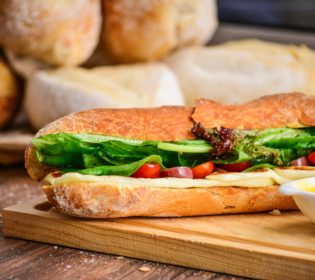Top Tips to Accommodate Alternative Diets on Your Menu
The new year is a big time for people to start looking at new diets to try and be healthier. Media outlets are saturated with stories of people who have had amazing results from keto, vegan, and vegetarian diets. With over 2.3 million vegetarians and 850,000 vegans in Canada[1], and nearly 4% of Canadians on the keto diet[2], it’s more apparent than ever that restaurants of all sizes need to adapt by finding ways to accommodate these diets on their menus.
Making changes to your menu to meet the needs of these diets can help your restaurant build a better relationship with your customers. People want to make informed decisions so they can feel more comfortable in their skin, and by providing them with the information they need and changes to make them feel welcome, your restaurant can show them you’re a reliable place to find the food they’re looking for.
To help you get started, we’ve put together our top tips for accommodating these different diets on your restaurant menu – these changes can help show your customers you’re ready to serve them, no matter what they eat!
What are some common diets?
There are several diets for people to choose from, with new ones coming out every few months. The most popular, however, have been around for years and are followed by many people around the world:
Vegetarian – Vegetarianism is a dietary choice that involves abstaining from eating meat. People who follow a vegetarian diet typically consume foods such as fruits, vegetables, eggs, dairy, grains, nuts, and seeds.
Vegan – Veganism is a type of vegetarian diet that excludes not only meat, but also all animal products such as dairy, eggs, and honey. Vegans follow a plant-based diet and often do so for ethical, environmental, and health reasons.
Gluten-free – A gluten-free diet excludes the protein gluten, which is found in grains such as wheat, barley, and rye. People who follow a gluten-free diet do so for medical reasons, such as celiac disease or non-celiac gluten sensitivity, or for personal reasons.
Keto – The ketogenic, or keto, diet is a high-fat, low-carbohydrate diet that is designed to help the body enter a state of ketosis, in which it begins to burn fat for fuel instead of carbohydrates. People who follow a keto diet typically eat a lot of healthy fats, moderate amounts of protein, and very few carbohydrates.
Paleo – The paleo diet, also known as the caveman or stone-age diet, is a dietary plan that is based on the type of foods that are thought to have been eaten by humans during the paleolithic era. This diet typically includes a wide variety of fruits and vegetables, nuts and seeds, and lean meats, and excludes processed foods, grains, legumes, and dairy products.
Low carb – A low-carbohydrate diet restricts the intake of carbohydrates, typically found in foods such as bread, pasta, and sugary snacks and beverages. People who follow a low-carb diet often do so to lose weight, improve their health, or manage certain medical conditions.
How to accommodate these diets on your menu
List nutritional information
By providing the calories of dishes on your menu and putting nutritional information online for your customers to read, you help them make informed decisions about the food they put in their bodies.
Many chain restaurants already present calories on their menu because of the Healthy Menu Choices Act in Ontario, which requires restaurants with over 20 locations to present this information for customers to see. By including this information as well, you can show your customers you want to help them.
Not sure how to find out the nutritional information of your dishes? Try using a nutrition calculator! By inputting the ingredients and amounts in your recipes, you can determine their caloric information.
 Identify diet-friendly foods on your menu
Identify diet-friendly foods on your menu
Let your customers easily find food they can enjoy by identifying diet-friendly foods with symbols on your menu. By using symbols, people with specific restrictions can easily find food they can enjoy without having to read through ingredient lists or descriptions.
Make sure that you use easy-to-understand symbols– for example, use a leaf to identify vegetarian meals, or a loaf of bread with a cross through it to identify gluten-free options. Be sure to also leave a legend on your menu where it’s easy to see.
Offer gluten-free and low-carb alternatives
Gluten-free and low-carb options for meals like pasta, pizza, and sandwiches are easier to come by than ever before. Gluten-free bread and low-carb pasta like shirataki noodles can be kept in the fridge, ready to use as requested by your customers.
By showing that you have these options available, your customers will feel seen and recognized, and be more willing to come back and try other dishes!
Make ingredient lists publicly available
Whether a customer has an allergy or a specific diet that they must practice, sometimes the easiest thing is to read an ingredient list to make sure they can eat a dish that you offer. Providing a list of ingredients for the dishes on your menu allows them to make informed decisions and shows that you’re willing to help them make the best choices for their needs.
Get your menu online
The world is online – people often check on their phones, computers, or tablets before they go to a restaurant to see what dishes a restaurant has to offer before they choose where they want to go. If your menu is online and up to date, with all allergen and diet information available, consumers can more easily make a decision about visiting your restaurant and enjoying themselves.
Why adapt your menu to these diets?
Consumers are often turning to new and healthier diets when they want to change their lifestyles; unfortunately, restaurants are often seen as an unhealthy choice. Providing alternatives and options shows that you are health-conscious and convenient, which helps build trust between you and the people who eat your food.
With the popularity of these diets and the increase in allergen awareness, there is a higher demand in the public for different options and menu transparency. Being clear with your customers helps build that trust and show them that you care.
If you’re a restaurant owner looking to prepare more healthy options for different diets, shop the Wholesale Club for healthy alternatives at great prices. View our flyer today!
[1] https://www.statista.com/topics/3262/vegan-vegetarian-diets-in-canada/#topicHeader__wrapper
[2] https://cdn.dal.ca/content/dam/dalhousie/pdf/sites/agri-food/Keto Report Jan 17 EN.pdf





















